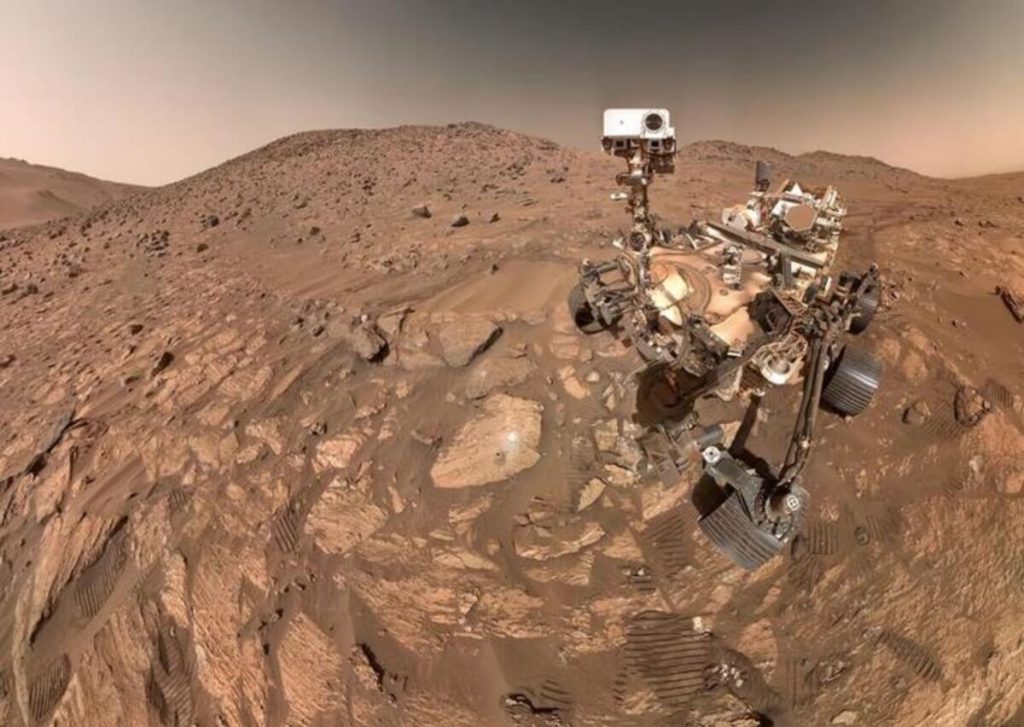

NASA’s Perseverance Mars rover took this selfie in July 2024. (Credit: NASA/JPL-Caltech/MSSS)
In a nutshell
- NASA’s Perseverance rover has collected the first carefully selected Martian soil samples from Jezero Crater, ranging from rock cores to tiny dust particles. These samples could reveal whether Mars once hosted life.
- The samples contain three key components: modern windblown dust, fine-grained material similar to global Mars soil, and chemically altered minerals showing signs of past water interaction – including phosphate, a compound crucial for life.
- These precious samples are scheduled to return to Earth between 2035 and 2039 through a complex retrieval mission, where they’ll be studied using advanced laboratory techniques to potentially reveal Mars’ ancient history and habitability.
LAS VEGAS — In the search for extraterrestrial life, few things are more valuable than a scoop of dirt, provided it’s from the right place. NASA’s Perseverance rover has now collected such samples from Mars’ Jezero Crater, a location specifically chosen for its potential to reveal whether the Red Planet once harbored life, according to a new international study.
The samples range from rock cores the size of classroom chalk to tiny grains of sand and dust small enough to fit on a needle tip. They were gathered from Jezero Crater, a 28-mile-wide former lakebed specifically chosen for its potential to help scientists understand Mars’ wet past.
The study, published in the Journal of Geophysical Research: Planets, took samples from a location dubbed “Observation Mountain” that measures roughly half a football field in length and about as wide as a large SUV. Unlike active dunes that shift with Martian winds, this stable formation contains both locally sourced rocky material and finer particles that may have traveled from distant parts of Mars, making it an ideal scientific target.
Perseverance used a specialized drill bit to collect material from about 2.5 inches below the surface. Initial analysis suggests three key components: modern windblown dust that could illuminate Mars’ current climate patterns, fine-grained material that appears similar to soil found across much of Mars, and chemically altered mineral grains that show signs of past interaction with water.


“The samples will help us learn more about Mars, but they can also help us learn more about Earth because the surface of Mars is generally much older than the surface of Earth,” says lead author Elisabeth Hausrath, professor at the University of Nevada, in a statement.
Unlike Earth, Mars lacks plate tectonics that constantly reshape its surface. This means Martian soil can preserve evidence from billions of years ago, similar to how scientists study tree rings or cave formations to understand Earth’s past climate. By studying these ancient materials, researchers hope to better understand not only Mars’ history but also how life might have emerged in our solar system.
The rover, nicknamed Percy, carries an impressive array of high-tech instruments that scientists can control from millions of miles away. These tools include lasers that can analyze rock chemistry from several meters away, specialized cameras that beam detailed images back to Earth, and sensitive detectors that can identify minute amounts of different chemical elements.
One of the rover’s most significant findings was detecting three distinct fluorescent signatures in the samples. While these glowing patterns match what scientists would expect from certain mineral features or rare earth elements, they could potentially indicate the presence of organic molecules. However, this can’t be confirmed until the samples are studied in Earth laboratories.


The samples also revealed fascinating details about Mars’ surface structure. The surface crust differs from deeper soil layers, with larger pebbles on top and finer grains below. Some particles show clear signs of weathering by water, suggesting potentially habitable environments existed in the past. The abundance of a mineral called olivine, which can undergo chemical changes when exposed to water, further supports the idea that liquid water once flowed through this region.
One particularly intriguing discovery is a rock nicknamed “Cheyava Falls” (after a Grand Canyon waterfall) that contains phosphate, a compound crucial for life on Earth, used in everything from DNA to cell membranes and energy metabolism. This finding adds to the growing evidence that Mars once had conditions suitable for life.
These precious samples are currently stored in tubes either on the rover or at a location called Three Forks, carefully mapped so they can be found even if covered by dust. NASA has collected 28 of its target 43 samples, which are scheduled to return to Earth between 2035 and 2039 through a complex retrieval mission involving NASA and the European Space Agency.
The mission serves multiple purposes beyond the search for ancient life. It acts as a crucial scouting mission for future human exploration of Mars. Previous space exploration has shown how important such preparation can be. For instance, when Apollo astronauts discovered that lunar dust was sharp enough to damage their spacesuits, something scientists hadn’t anticipated. Understanding Mars’ soil properties could help prevent similar surprises for future Mars explorers.
As these Martian samples begin their long journey back to Earth, they carry with them the potential to answer questions that have intrigued humanity for centuries. Their analysis won’t just tell us about Mars; it will help us understand our own planet’s history and perhaps even shed light on the origins of life itself. The next decade of Mars research promises to be transformative, not just for planetary science, but for our understanding of our place in the cosmos.
Paper Summary
Methodology
The sampling process involved using a specialized hollow drill bit with two 8mm x 8mm openings to collect material from beneath the surface. The drill penetrated about 6.5cm down and swept back and forth while rotating and vibrating to encourage material flow into the collection tube. Laboratory tests on Earth confirmed this technique could effectively sample both surface and subsurface material to depths of 4-6cm.
Results
Analysis revealed three main components: 1) Recent airfall dust containing various chemical signatures, 2) Fine-grained material averaging 125-150 micrometers that matches a proposed “global” Mars soil component, and 3) Coarser grains showing evidence of aqueous alteration. The samples also contained soil crusts and showed three distinct fluorescence patterns that could indicate either mineral or organic sources.
Limitations
The most significant limitation is that detailed chemical and physical analysis requires sophisticated laboratory equipment not available on Mars. While the rover’s instruments provided valuable preliminary data, definitive conclusions about many aspects of the samples will have to wait until they can be returned to Earth by future missions.
Discussion and Takeaways
The samples provide evidence for both ancient wet environments that could have been habitable and ongoing surface-atmosphere interactions involving water vapor. They also offer potential insights into Mars’ climate history through preserved dust components. The presence of altered minerals suggests these materials could preserve biosignatures if life ever existed in these environments.
Funding and Disclosures
The research involved numerous international institutions and was supported by various space agencies including NASA, CNES (French Space Agency), and other organizations. The complete list of funding sources and author affiliations is extensive due to the collaborative nature of Mars exploration missions.
Publication Information
The study was published in the Journal of Geophysical Research: Planets (2025), Volume 130, under the title “Collection and In Situ Analyses of Regolith Samples by the Mars 2020 Rover: Implications for Their Formation and Alteration History” by Hausrath et al.








